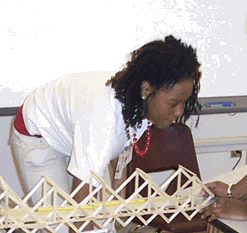|
|
|
|
|
|
|
News & Views item - July 2011 |
![]() Are Lessons from the NSF's GK-12 Program Cogent for Australia? (July 15,
2011)
Are Lessons from the NSF's GK-12 Program Cogent for Australia? (July 15,
2011)
 In
1999, under the direction of Rita Colwell, the U.S. National Science Foundation
(NSF) began a Graduate STEM Fellows in K–12 Education program (GK–12). Now
NSF officials have decided that the program has served its purpose; consequently
President Obama's 2012 budget request excludes the US$55-million-a-year
successful fellowship program that has brought more than 10,000 STEM graduate
students into elementary and secondary schools around the United States.
Typically, GK-12 grants were for 5-years to principal investigators who
supervised from 8-10 students working toward advanced degrees in the sciences,
technology, engineering or mathematics.
In
1999, under the direction of Rita Colwell, the U.S. National Science Foundation
(NSF) began a Graduate STEM Fellows in K–12 Education program (GK–12). Now
NSF officials have decided that the program has served its purpose; consequently
President Obama's 2012 budget request excludes the US$55-million-a-year
successful fellowship program that has brought more than 10,000 STEM graduate
students into elementary and secondary schools around the United States.
Typically, GK-12 grants were for 5-years to principal investigators who
supervised from 8-10 students working toward advanced degrees in the sciences,
technology, engineering or mathematics.
Those involved in the program are dumbfounded. An evaluation of the program published at the beginning of the year found it "brings science to life for students, improves the skills of their teachers, and offers graduate students valuable training in the classroom. Susan Williams of the Bodega Marine Laboratory at the University of California, Davis rhetorically asked Science's Jeffery Mervis: "Where are we going to move to? GK-12 is irreplaceable. It addresses the pipeline issue in a way that no other graduate training program does. Having young scientists as role models can make a lasting impact on students, and the program is large enough to have a real impact on K–12 STEM education," and Professor Calwell who now holds joint appointments at the University of Maryland, College Park, and at Johns Hopkins University Bloomberg School of Public Health in Baltimore, Maryland says ending GK-12 is: "...unfortunate. It's been extraordinarily successful. Of course there are other programs for graduate students. But this is unique in using them to bring science into the K–12 class at the same time it supports their graduate education. And given the poor state of STEM education in the schools, this is vitally important."
Now Richard D. Boone (professor in the Department of Biology and Wildlife and the Institute of Arctic Biology, University of Alaska Fairbanks, Fairbanks, AK) and Pat Marsteller (professor in the Department of Biology, director of the Emory College Center for Science Education, and director of the Hughes Science Initiative, Emory University, Atlanta, GA.) have written a joint editorial for Science noting the success of GK-12 and again emphasising: "To date, the NSF GK–12 program has provided more than 10,000 STEM graduate students (GK–12 Fellows) with training in communication and pedagogy. The Fellows work directly with K–12 students 10 to 15 hours weekly for an entire school year. These young students engage in hands-on research with the Fellows, who serve as STEM experts in partnership with teachers... [and an] independent NSF-contracted assessment of the program found that compared to their peers, GK–12 Fellows were more engaged in their research, better able to explain STEM concepts to nontechnical audiences, and more interested in the connection between STEM education and public policy... The program has benefited more than 6000 public schools, nearly 12,000 teachers, and some 634,000 students."
Professors Boone and Marsteller conclude: "The GK–12 program has been a powerful force for strengthening education in the United States. It's time to take it to the next level."
Whether or not their plea and those of the many other participants in the program will be heeded remains to be seen but with regard to the condition of STEM education in Australia's primary and secondary schools mightn't it be sensible to undertake a program comparable to GK-12.
The 330-page evaluation of the program as well as a 16-page summary are available here.